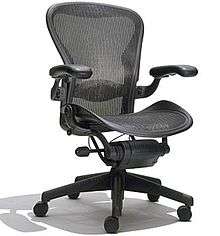Office chair

An office chair, or desk chair, is a type of chair that is designed for use at a desk in an office. It is usually a swivel chair, with a set of wheels for mobility and adjustable height. Modern office chairs typically use a single, distinctive load bearing leg (often called a gas lift), which is positioned underneath the chair seat. Near the floor this leg spreads out into several smaller feet, which are often wheeled and called castors. Office chairs were developed around the mid-19th century as more workers spent their shifts sitting at a desk, leading to the adoption of several features not found on other chairs.
History
One of the earliest known innovators to have created the modern office chair was naturalist Charles Darwin, who put wheels on the chair in his study so he could get to his specimens more quickly.[1]
With the advent of rail transport in the mid-19th century, businesses began to expand beyond the traditional model of a family business with little emphasis on administration. Additional administrative staff was required to keep up with orders, bookkeeping, and correspondence as businesses expanded their service areas. While office work was expanding, an awareness of office environments, technology, and equipment became part of the cultural focus on increasing productivity. This awareness gave rise to chairs designed specifically for these new administrative employees: office chairs. This caught the attention of Otto von Bismarck, who is credited with popularizing the office chair by distributing them throughout parliament during his time in office. American inventor Thomas E. Warren (b. 1808), designed the Centripetal Spring Armchair in 1849 which was produced by the American Chair Company in Troy, New York.[2] It was first presented at the 1851 Great Exhibition in London.[3]
The office chair was strategically designed to increase the productivity of clerical employees by making it possible for them to remain sitting at their desks for long periods of time. A swiveling chair with casters allowed employees to remain sitting and yet reach a number of locations within their work area, eliminating the time and energy expended in standing. The wooden saddle seat was designed to fit and support the body of a sitting employee, and the slatted back and armrests provided additional support to increase the employee’s comfort. Like modern chairs, many of these models were somewhat adjustable to provide the maximum comfort and thus the maximum working time.
Types
There are multiple kinds of office chairs designed to suit different needs. The most basic is the task chair, which typically does not offer lumbar support or a headrest. These chairs generally cannot be sat in for more than a couple hours at a time without becoming uncomfortable, though they often offer more room to move than higher-end chairs.
Mid-back chairs offer fuller back support, and with the right ergonomic design, can be sat in for a four hours at a time or longer. High-end chairs in this category, such as the Herman Miller Aeron, are comfortable for long periods.
Executive or full-back chairs offer full back and head support. Many executive chairs are designed to be sat in for eight or more hours at a time. These are typically the most expensive office chairs.

Ergonomics
In the 1970s, ergonomics became an important design consideration. Today, office chairs often have adjustable seats, armrests, backs, back supports, and heights to prevent repetitive stress injury and back pain associated with sitting for long periods. Ergonomic chairs fit an individual's needs and provide support where the individual needs it. Standard for the design and testing of office chairs include:
- EN 1335:2012
- EN 1728:2012
- ANSI/BIFMA X 5.1
- DIN EN 1335
- DIN 4551
- AS/NZS 4438
Common repairs
Over time office chairs wear out and break.[4] Seat cushions may lose their softness or become discolored and are not repairable.[4] Casters can stop spinning and scrape or carve grooves into the floor.[4] These are a standard part and can be re-lubricated[5] or replaced inexpensively.[6] The gas cylinder used for height adjustment may leak and provide no support.[4] This can be repaired using a replacement gas cylinder or by providing support through other means.[7] The chair armrests may break or come loose; these can be repaired or replaced as well.[5]
See also
References
- ↑ "On Darwin's 200th, a theory still in controversy". Associated Press by way of Fox News. February 8, 2009. Retrieved July 20, 2017.
- ↑ Murphy, Heather (30 May 2012). "The Quest for the Perfect Office Chair". Slate magazine. Retrieved 30 May 2012. Referencing Olivares (2011).
- ↑ Bishop, J. Leander (2006). History Of American Manufactures From 1608 To 1860 - Volume 2. Kessinger Publishing. ISBN 1425495141.
- 1 2 3 4 MacIntyre, Cath (27 December 2017). "Three Easy Fixes for Home Office Chairs So You'll Be Sitting Pretty". The Spruce. Retrieved 25 May 2017.
- 1 2 "How to Repair an Office Chair". eBay.
- ↑ "Office Chair Caster Guide". www.ontimesupplies.com.
- ↑ "How to Fix a Sinking Desk Chair". wikiHow.